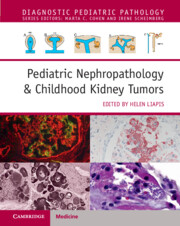Book contents
- Pediatric Nephropathology & Childhood Kidney Tumors
- Diagnostic Pediatric Pathology
- Pediatric Nephropathology & Childhood Kidney Tumors
- Copyright page
- Dedication
- Contents
- Contributors
- Preface
- Section 1 Normal and Abnormal Human Kidney Development
- Section 2 Glomerular Diseases
- Chapter 3 Idiopathic and Hereditary Proteinuric Glomerular Diseases
- Chapter 4 Haematuric Glomerular Diseases (Collagenopathies)
- Chapter 5 Immune Complex Mediated Glomerular Diseases
- Chapter 6 Inherited Metabolic Diseases Affecting the Kidney
- Chapter 7 Glomerular Diseases with Fibrillary Deposits
- Chapter 8 Mitochondrial Diseases in the Pediatric Kidney
- Section 3 Tubulointerstitial Diseases
- Section 4 Vascular Diseases
- Section 5 Infectious Diseases
- Section 6 Cystic Diseases
- Section 7 Solid Tumors of the Kidney
- Section 8 Transplant Pathology of the Kidney
- Index
- References
Chapter 6 - Inherited Metabolic Diseases Affecting the Kidney
from Section 2 - Glomerular Diseases
Published online by Cambridge University Press: 10 August 2023
- Pediatric Nephropathology & Childhood Kidney Tumors
- Diagnostic Pediatric Pathology
- Pediatric Nephropathology & Childhood Kidney Tumors
- Copyright page
- Dedication
- Contents
- Contributors
- Preface
- Section 1 Normal and Abnormal Human Kidney Development
- Section 2 Glomerular Diseases
- Chapter 3 Idiopathic and Hereditary Proteinuric Glomerular Diseases
- Chapter 4 Haematuric Glomerular Diseases (Collagenopathies)
- Chapter 5 Immune Complex Mediated Glomerular Diseases
- Chapter 6 Inherited Metabolic Diseases Affecting the Kidney
- Chapter 7 Glomerular Diseases with Fibrillary Deposits
- Chapter 8 Mitochondrial Diseases in the Pediatric Kidney
- Section 3 Tubulointerstitial Diseases
- Section 4 Vascular Diseases
- Section 5 Infectious Diseases
- Section 6 Cystic Diseases
- Section 7 Solid Tumors of the Kidney
- Section 8 Transplant Pathology of the Kidney
- Index
- References
Summary
This chapter addresses the clinicopathologic features of kidney diseases in various categories of inherited metabolic diseases or inborn errors of metabolism, most often secondary to a systemic disease in the pediatric population. Considering the rarity of these diseases, renal involvement may be silent, purely functional and/or manifest parenchymal alterations with organ dysfunction. They may affect the glomerular, tubulo-interstitial or rarely vascular compartments, although they are not mutually exclusive in a given disease. The major groups of diseases include various forms of lipid, protein/lipoprotein, glycogen disorders and other organic substances, as a result of specific cellular organelle dysfunction or an inherited enzyme deficiency, allowing for accumulation of abnormal metabolites or substrates that cells are unable to eliminate effectively. The clinical manifestations may appear during the neonatal period or develop later during childhood with progressive organ dysfunction with a wide spectrum of signs and symptoms, having an acute, subacute or chronic presentation. The age of onset and disease severity may depend on the inheritance patterns and the type of gene mutations, as well as environmental influences. A detailed family history and genetic studies are often useful, along with clinical and laboratory findings at the time of presentation, to make a definitive diagnosis. Although the kidney is rarely a target organ, when affected, a renal biopsy is valuable in establishing a diagnosis and also in further delineating specific entities, based on their unique clinical, pathological, histochemical, ultrastructural and molecular/genetic characteristics.
Keywords
- Type
- Chapter
- Information
- Pediatric Nephropathology & Childhood Kidney Tumors , pp. 121 - 158Publisher: Cambridge University PressPrint publication year: 2023
References
- 1
- Cited by



